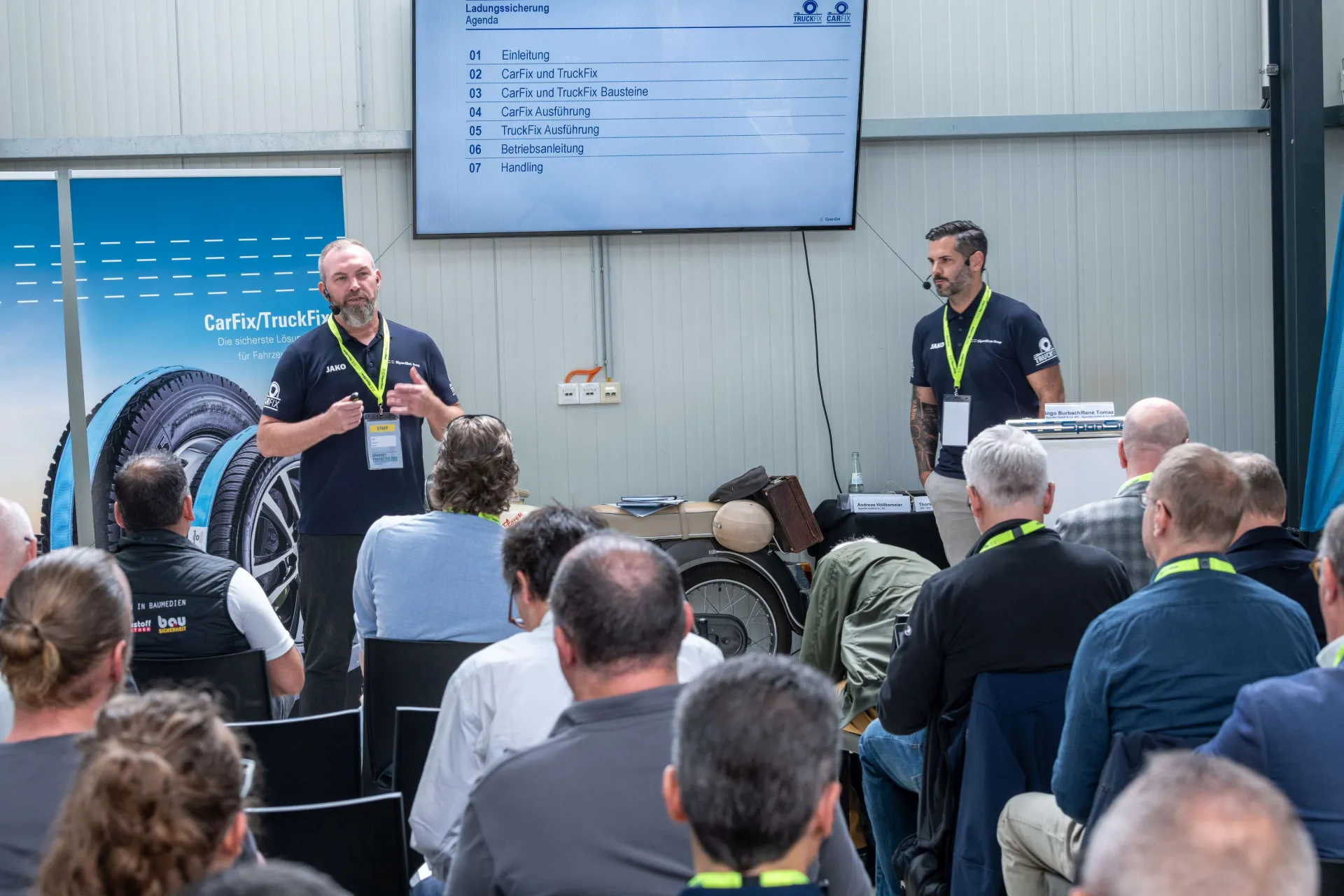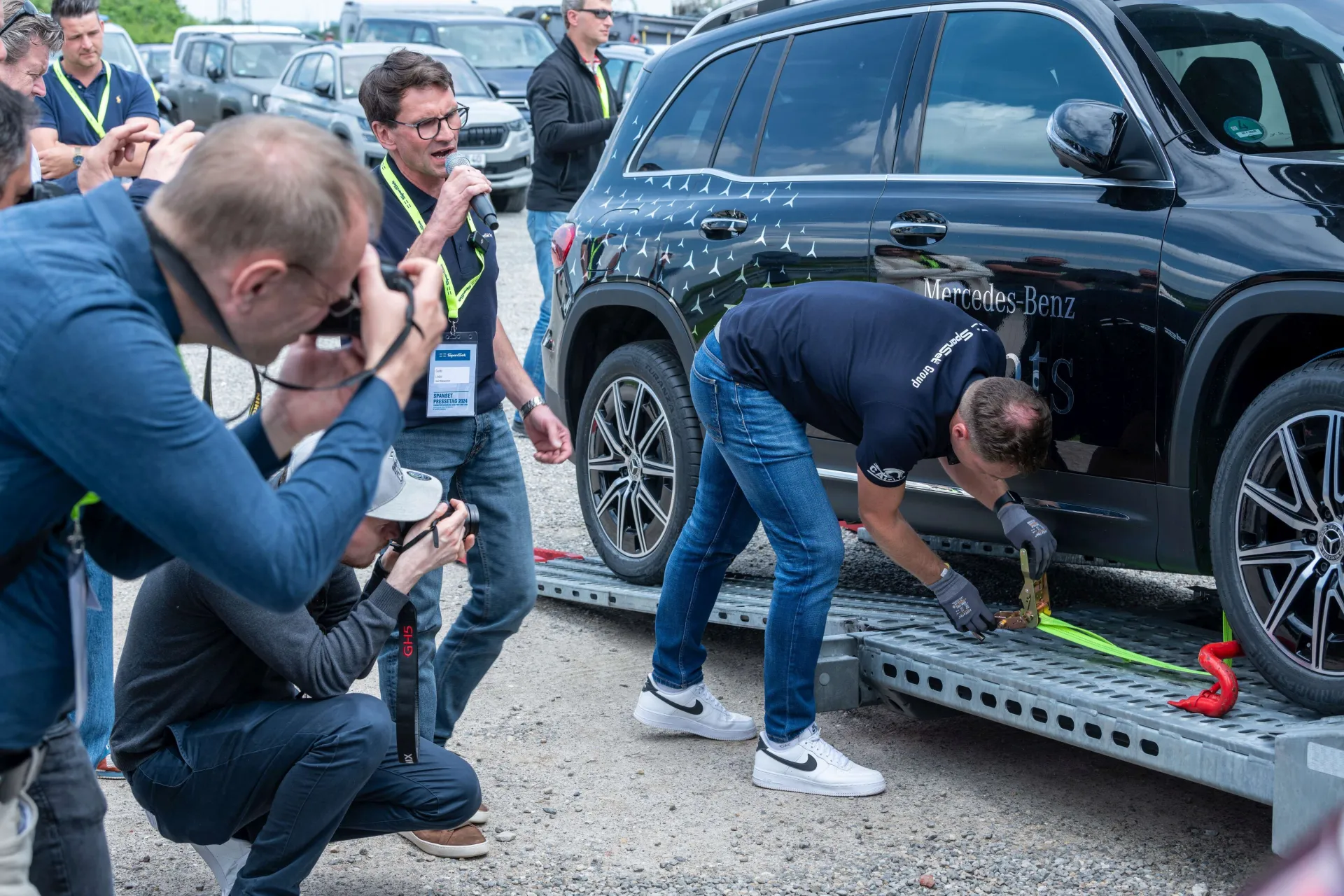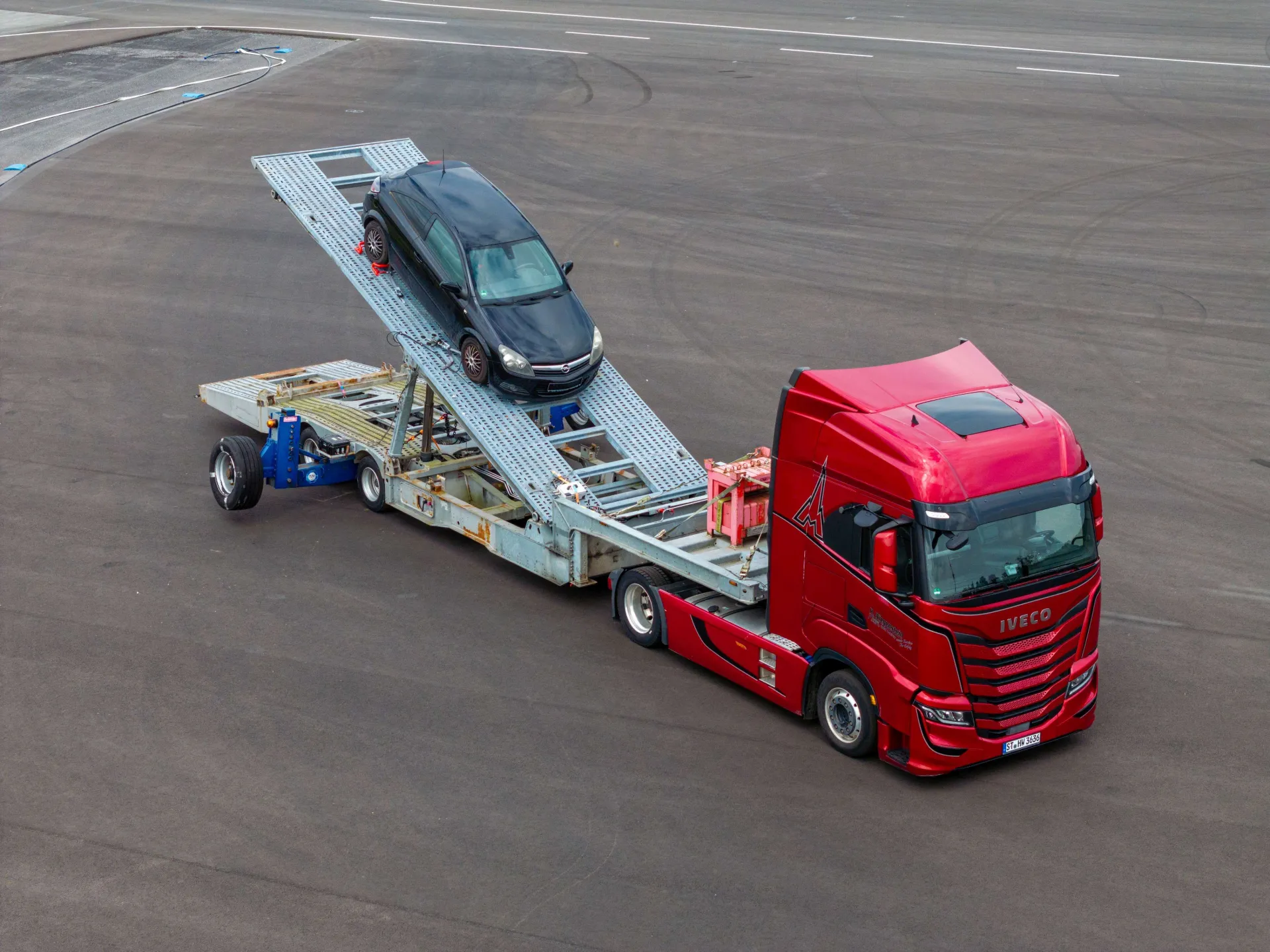NNew VDI Guideline Affects Tie-Downs, Wheel Chocks, and Vehicles
Übach-Palenberg, June 4, 2024 – The revised VDI 2700 guideline is set to take effect on September 1 this year. The guideline addresses load securing for passenger cars and trucks on road vehicles. It defines the state of the art, which will be of significant relevance, especially during police checks and court proceedings. The load securing specialist SpanSet invited industry professionals to an information event in early June. The turnout and demand for information were high.
The SpanSet conference at the Aldenhoven Testing Center quickly sold out. More than 60 experts, including many trade journalists, attended the symposium with lectures and live demonstrations. The main focus was on the revised and expanded VDI guideline 2700 (Sheets 8 ff.), which deals with load securing for passenger cars and trucks on road transporters.
Fundamental Revision and Expansion of VDI 2700 Sheets 8, 8.1, and 8.2
"VDI guidelines are reviewed every five years," reported Simon Jäckel, scientific associate at the German Association of Engineers (VDI). "There are three options: confirm, revise, or withdraw."
When the revision of the VDI 2700 Sheets 8, 8.1, and 8.2 was due in 2017, it quickly became clear that a thorough update was required. This process would take several years. "The load securing technology has advanced significantly, and the vehicles on the transport platforms have also changed," said Jäckel. Just think of SUVs with their enormous tires or heavy electric cars (see Info Box 1: "I think that's great!").
For the revision of VDI 2700 Sheets 8, 8.1, and 8.2, a committee was formed, including representatives from industry, testing companies, and regulatory authorities. The first task was to determine the focus of the committee. The result: the transport vehicle, load securing equipment, and the vehicles to be transported all had to be taken into account. "We described these components precisely to derive comprehensible and feasible load securing methods," explained committee chairman Hans-Josef Neunfinger about the early stages of the project.
For example: How much deformation of the floor plate is allowed?
Then began the fine-tuning: How should the tie-down equipment be designed? What requirements must the floor elements meet? How stable must the vehicle transporter be? "There were hundreds of tests with a manufacturer-neutral test vehicle," explained Thorsten Ludwig, Head of Load Securing at TÜV Süd. "Just the question of how much deformation caused by hooks on the floor plate was permissible kept us occupied for several weeks."
Why so long? Because the devil is in the details! The expert committee faced a remarkable challenge when dealing with the floor plates, as Ludwig explained during his presentation: "When you apply force to a floor plate, it deforms. It definitely doesn't work without deformation." So, the question arose: How much deformation is allowed? The VDI guideline, after numerous tests, provides the answer: A maximum of three millimeters of plastic deformation in the area of force application is "state of the art" and permissible, as long as the deformation does not impair the function of the floor plate.
Or the wheel chocks
Another example: the wheel chocks. The new guideline stipulates that their height for car transport must be at least one-sixth of the tire diameter, and for small tires, at least 120 millimeters. And what must they withstand? The guideline specifies that the blocking force in the horizontal direction must be at least 500 daN.
The meticulous work of the committee is demonstrated by a side note from Neunfinger: "To define the friction forces between the floor plate and the tire, we had to determine a new value and invent a new term: sliding friction resistance coefficient." This must be at least 0.4. (See Info Box 2: VDI as Word Creators)
Guideline Effective Immediately Upon Publication
That the soon-to-be-published VDI 2700 (Sheets 8 ff.) is not just a theoretical and detail-obsessed result of the committee’s work was emphasized by Thorsten Ludwig. He pointed out that it will impact daily loading operations: "Once published, the guideline will apply to all vehicles on German roads, regardless of their age." Whether the cargo being transported is regular cars, trucks, vintage vehicles, caravans, or motorhomes is irrelevant. Anyone transporting a vehicle privately must also adhere to VDI 2700.
Warning of a Bitter Awakening
Thorsten Ludwig from TÜV warned practitioners: "Freight forwarders and carriers should not assume that their clients will load vehicles even if they cannot prove the compliance of their equipment with VDI standards. It's not enough to just say, 'You need us to transport your cars and trucks.'"
The legal situation is clear: The consignor is also liable. If there is a violation, they face the same consequences as the driver. Ludwig made a prediction that was met with widespread agreement: "At the OEMs, you won't find a logistics manager who voluntarily accepts points on their personal driving record just because they allowed an inadequately secured transporter to leave the premises."
Does My Equipment Meet the VDI Guideline?
What Thorsten Ludwig advises against: "Now, don't just buy hooks or tie-down straps wildly." First, vehicle owners should check whether their existing equipment complies with the guidelines. In most cases, it probably does, as the guideline reflects the state of the art. That means the technology is available. Whether it applies to the specific case is another matter. (See Info Box 3: "Contact the Vehicle Manufacturer")
Approval for Release on the Day of the SpanSet Symposium
When will the revised VDI 2700 officially take effect? "An hour before the event began, I approved the printing of the final draft," said Neunfinger. That was on June 4. The final draft is the definitive version. If nothing unexpected occurs, the guideline will be published on September 1, 2024. From then on, it will apply – without a transition period.
"I think that's great!"
"We're dealing with a significant revision. That's why there was a lot of discussion and exchange among the volunteer experts who formed the committee," said Simon Jäckel, Senior Project Manager at VDI. In this case, around 20 people from production (vehicle bodies, tie-downs, trucks, cars) and services (transport, accident insurance, testing) were involved. A consensus had to be reached among all participants – some of whom are competitors. In VDI language, consensus means: the absence of sustained opposition.
"That there's been a comprehensive event to inform the industry and the press about the final version of the new guideline before its publication, I've never experienced in my 12 years at VDI," Jäckel praised SpanSet’s initiative. "I think that's great."
VDI as Word Creators: Sliding Friction Resistance Coefficient
In the field of load securing, the term coefficient of sliding friction or friction coefficient is well-known. It indicates the "micro-engagement" (friction) between the loading surface and the load. For the new version of VDI 2700, the committee had to invent a new term: sliding friction resistance coefficient. As committee chairman Hans-Josef Neunfinger explained: "When determining the friction coefficient conventionally, it's assumed that the load stands on a homogeneous surface, no matter how it's designed. But when loading cars or trucks onto transporters, the tires sit on patterned sheets. This creates an engagement and improves load securing. To make this clear, we coined the term 'sliding friction resistance coefficient.'"
The VDI 2700 defines that manufacturers of floor plates must prove that their products create a sliding friction resistance coefficient of at least 0.4. Otherwise, they cannot be used for loading cars and trucks onto transporters.
"Contact the Vehicle Manufacturer"
As of now, it is expected that the new VDI guideline will be published on September 1, 2024. From that point on, it will apply without a transition period. But how can a vehicle owner know if their truck meets the requirements? Thorsten Ludwig from TÜV Süd, Head of Load Securing, advises: "We recommend that vehicle owners contact the manufacturers of their trucks, bodies, and equipment. Ask them if the vehicle and materials meet the guideline. In most cases, manufacturers will provide a corresponding confirmation. However, it may happen that the manufacturer no longer exists or that the vehicle is very old and the manufacturer cannot certify it. In such cases, I recommend involving TÜV Süd. We can help."
Individual Inspections
Vehicles that transport cars or trucks must undergo individual inspections according to VDI 2700 (Sheets 8, 8.1, and 8.2) for the following components:
· Floor elements (load securing points and sliding friction resistance coefficient)
· Wheel chocks in conjunction with floor elements
· Tie-down equipment
· Strap controllers
· Vehicle transporter construction (stability of the transporter)

Fig. 1: Simon Jäckel, Scientific Associate at the German Association of Engineers (VDI)

Fig. 2: Hans-Josef Neunfinger, Chairman of the VDI 2700 (Sheets 8, 8.1, and 8.2) Guideline Committee

Fig. 3: Thorsten Ludwig, TÜV Süd, Head of Load Securing

Fig. 4: SpanSet Managing Directors Patrick Schulte (left) and Andreas Höltkemeier welcomed more than 60 experts and trade journalists to the conference on "Load Securing of Cars and Trucks" at the Aldenhoven Testing Center.

Fig. 5: SpanSet employees Ingo Burbach (left) and Rene Tomaz presented the load securing systems CarFix and TruckFix: SpanSet products meet the requirements of the new VDI guideline.

Fig. 6: Product Manager Werner Glasen moderated the presentation of SpanSet products CarFix and TruckFix.

Fig. 7: Practical demonstrations with Marc Böhme (at the microphone) and Guido Lieder.

Fig. 8: Secured according to the guidelines – nothing happens during an emergency stop. Driving and braking demonstration at the Aldenhoven Testing Center.

Fig. 9: Group photo of all participants on June 4 in Aldenhoven.